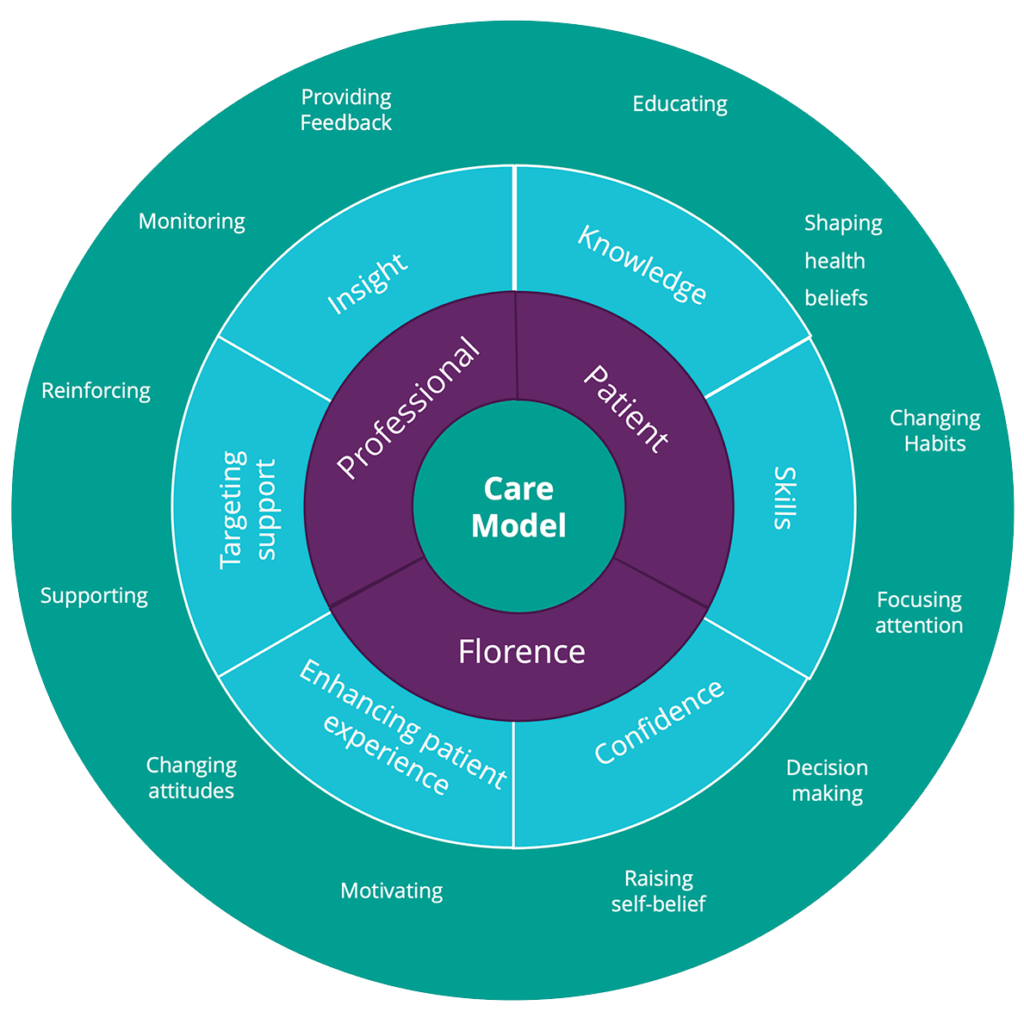Since it was first created over 10 years ago, Florence Intelligent Health Messaging has always been a tool to support patients with behavioral change. With the roll-out of our latest version of Florence (Florence 3.0), we’ve got more tools in our behavioral toolbox than ever before! To help our customers make the most of Florence’s behavior change functionality, we have re-designed our Florence Behavior Change Framework. The Flo BCF helps customers to design content which best supports their patients to self-manage their health, and signpost them to the tools in Florence which are likely to be the most impactful. To learn more about how to use the Flo BCF, keep reading, or book a demonstration here.
The centre of the Flo BCF is the care model that is created when customers incorporate Florence as part of their care delivery – it shows a patient, professional and Florence working together. In this care model, Florence acts as a bridge between a professional and the patient. Patients and professionals interact with Florence directly, but also directly with each other. This is important, because we know that Florence works best when she is enhancing the care that patients are receiving from a ‘real’ health or social care professional.
The next layer of the Flo BCF is how we structure the support that Florence provides to both patients and clinicians by creating this care model. The three segments on the right-hand side of this ring represent the outcomes we want patients to achieve from a Florence enabled care model. These include Knowledge, Skills, and Confidence to self-manage their health. By using Florence, we want patients to learn more about their health, and their role in it. We also want them to develop the skills they need to manage their health and build the confidence to change and maintain the healthy behaviors that will keep them well.
The three segments on the left-hand side of this layer identify how Florence can support health and social care professionals to deliver care to patients. These factors are Better Insight, Targeting Support, and Enhancing Patient Experience. Better insights are achieved from receiving more information about their patients, so that professionals know how best to support them. The alerts, trends, and data Florence collects about patients can also be used to help health and social care professionals better target their support towards patients who need it most, and letting Florence look after patients who are able to successfully self-manage their condition. By delivering enhancements to existing care using Florence, we also empower health and social care professionals to deliver the high-quality patient experience we know they want to provide, but often lack the time and resources to do so.
To achieve better outcomes, both patients and clinicians may need to change their behaviors. Behaviors are the things that people do. Self-management of health by patients requires the performance of a wide range of ‘healthy’ behaviors, and often reducing or stopping the performance of ‘unhealthy’ behaviors. Clinicians also need to perform behaviors to support patients with their health, such as examining patients, gathering information, coaching, and/or providing medication. Whilst all professionals will know how to perform these behaviors, completing them can be difficult. This might be due to lack of time to spend with patients to perform these behaviors. Or it could be a lack of information about patients to know which patients need what behaviors to be performed.
At Florence Intelligent Health Messaging, we understand the complexity of changing behaviors. We also have extensive experience working with health and social care professionals to support behavioral change as part of a Florence care model. We can help customers to identify the behaviors which are most important to change (which is an art and science in itself!) and design the content which is going to achieve the best outcomes for patients. And this leads us to the outer layer of the Flo BCF, which shows the many ways that Florence can support behavior change to achieve the outcomes in the inner ring. These are Florence’s ‘mechanisms of action’.
A Behavior Change Technique (BCT) is the smallest unit of how we change behavior. There are 93 techniques in the current taxonomy, and Florence’s technology can deliver or support the delivery of 80 of these (though we don’t recommend some of them as part of a supportive self-management programme – more on this in a future blog!) Florence’s ‘mechanisms of action’ have been mapped directly to the BCT taxonomy, and we also have a library of examples from our experience which is growing all the time.
As a Florence customer, we will support you to select the right ‘mechanisms of action’ for your patient group and show you how best to deliver them using Florence. We want our customers to get the most out of Florence’s behavior change functionality and have the best chance at improving patient outcomes. It’s what we’re passionate about.
If you’d like to learn more about how Florence Intelligent Health Messaging can help you and your patients with behavioral change, book a demonstration here.
